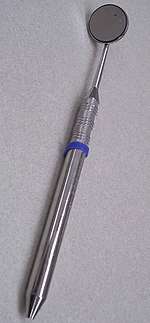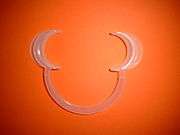Dental instrument
Dental instruments are tools that dental professionals use to provide dental treatment. They include tools to examine, manipulate, treat, restore and remove teeth and surrounding oral structures.[1]

Examination instruments
These tools allow dental professionals to manipulate tissues for better visual access during treatment or during dental examination.
Dental Mirror
Dental mirrors are used by the dentist or dental auxiliary to view a mirror image of the teeth in locations of the mouth where visibility is difficult or impossible. They also are used for reflecting light onto desired surfaces, and for retraction of soft tissues to improve access or vision.
Probes
- Dental explorer (sickle probe)
- Periodontal probe
Local anesthesia
- Dental anesthesia and dental syringe
Anesthesia is broken down into three main categories: local, regional, and general, all of which affect the nervous system in some way and can be administered using various methods and different medications.
Local anesthesia is an anesthetic drug (which can be given as a shot, spray, or ointment) that numbs only a small, specific area of the body (for example, a foot, hand, or patch of skin). With local anesthesia, a person is awake while sedated. Local anesthesia lasts for a short period of time and is often used for minor outpatient procedures (when patients come in for surgery and can go home that same day). For someone having outpatient surgery in a clinic or doctor's office (such as the dentist or dermatologist), this anesthetic is likely used. The medicine can numb the area during the procedure and for a short time afterwards to help control post-surgery discomfort.
The function of this instrument involves successfully piercing the surface of the periodontal ligament so the patient can be distributed the anesthesia.[2] Past devices have proven to be insufficient because it instilled fear in patients and made it exhaustingly uncomfortable for dentists to use because of the bulky size.[2] With how simple it is to hide it in the hand due to the smaller size of modern day anesthetic syringes, dentists are successfully able to maneuver in a patient's mouth without causing harm to the patient being treated, allowing for a quick insert of the anesthesia followed by the dentist being able move on swiftly to the next task of the dental visit.[2] Another aspect of the syringe is the capability of use, which means dentists are able to easily insert fluid in the device and follow the color coded instructions that allow for efficient use of the dental instrument.[3] The device is so intricately sized that doctors are able to grip it well enough to get the job done.[3] Some Anesthetic Syringes also include a power handle that gives the doctor less of a responsibility over the amount of pressure needed to push in the medicine because the power handle has settings that let the Dentist set an amount for how much anesthetic they want to be produced.[3]
Dental handpieces

Dental handpieces come in many various types which include: High speed air driven (also known as an airotor), slow speed, friction grip, surgical hand piece.
Dental laser
A dental laser is a type of laser designed specifically for use in oral surgery or dentistry.
The use of a laser can decrease morbidity after surgery, and reduces the need for anesthetics. Because of the cauterization of tissue there will be little bleeding following soft tissue procedures, and some risks of alternative electrosurgery procedures are avoided.
Dental torque wrench
A dental torque wrench or restorative torque wrench is a torque wrench used to precisely apply a specific torque to a fastener bolt for fixation of an abutment, dentures or prosthetics on a dental implant.[4]
Burs
Dental Burs cutting surface are either made of a multifluted tungsten carbide, a diamond coated tip, or a stainless steel multi fluted rosehead. There are many different types and classifications of burs. Some of the most common are: the round bur (sizes ¼ to 10) or inverted cone (sizes 33½ to 90L). Burs are also classified by the type of shank. For instance a latch type, or right angle bur, is only used in the slow speed handpiece with contra-angle attachment. Long shank or shaft is only used in the slow speed when the contra-angle is not in use, and finally a friction grip bur, which is a small bur, is used only in the high-speed handpiece.
There are many bur shapes that are utilized in various specific procedures.
Operative burs
Flat fissure, pear-shaped, football, round, tapered, flame, chamfer, bevel, end cut, bud bur, steel, inverted cone, diamond, brown stone, and green-stone
Restorative instruments
Excavators
- Spoon excavator: Used to remove soft carious decay.
- Half hollenbach: Used to test for overhangs or flash.
- Dental hatchers: Used to widen the entrance of the tooth cavity and slice away the thin carious enamel.[5]
- Chisels:
- Straight - bevels the cavosurface margin and used in 3, 4 and 5 classifications of cavities on the maxillary.
- Wedelstaedt - only used in the anterior for classes 3, 4 and 5 as well.
- Bin Angle - this is held in a pen grasp and used for class 2 maxillary only.
Burnishers
- Flat plastic
- Ball burnisher
- Beavertail burnisher
- Cone burnisher
- Pear shaped burnisher
Burnishers are used for polishing and contouring amalgam fillings and to polish composite fillings.
Pluggers
Pluggers are also known as amalgam condensers. They are used to achieve a well condensed filling by compressing the filling material into the cavity and applying pressure.[6]
- Amalgam plugger
- 49 plugger
Periodontal instruments
Fine scalers
These are used in the removal of soft deposit. They include:
- MF 4/5
- Drury scalers
- Fine excavators
Heavy scalers Are seen as the scalers used in the removal for heavy tartar and stain which are not been removed by the fine scalers. They include:
- Scaler 152
- Jacquette 1
- Jacquette 2
- Jacquette 3
- American pattern B
- Excavator
- Hoe scaler
- Cushion scaler
Curettes
Types include:
- Universal curettes - these have a semicircular tip used at 90° to the tooth root surface.
- Gracey curettes - semicircle tipped, but one edge lower than the other. It is used at 70° to the tooth root surface.
Prosthodontic instruments
Removable prosthodontics
- Spatulas for mixing Dental plaster
- Spatulas for mixing Impression materials
- Mixing bowls
- Glass mixing slab
- Fox plane
- Willis gauge
- Calipers
- Bunsen burner
- Blow torch
- Wax knife
- Wax spatula
- Wax carver
- Lecrons carver
- Articulators
- Face bow
Extraction/surgical instruments
Dental forceps
In 1840, Sir John Tomes and his friend Evrard made the first pair of dental forceps.[7] In 1841, Tomes posted an article to tell the whole world about his discovery of new forceps that have never been seen before, successfully becoming the creator of the forceps and the concept of forceps.[7] In earlier times, or during the eighteenth and nineteenth centuries, elevators and pelicans were used as extraction devices because the idea of dental forceps did not exist, but the thought of extracting in the first place with some form of a tool was there.[8] With pelicans, their sharp talons were used to be placed down on the inside of the mouth near the gums while the elevator helped pull the tooth out of its socket. Then, a pair of pincers would do the rest of the job, wiggling the tooth out of the gum until the extraction was complete.[8] The functionality of today's Dental Forceps come from the need to remove items from the mouth such as the cotton balls Dentists place next to a patient's teeth or the rubber bands a patient needs for their braces.[9] However, most dental forceps are not designed for comfort, nor do they take the account of the dental practitioners hand positions throughout the procedure to mind.[9] Dental forceps have been designed to the point where Dentists experience medical complications of their own on the carpal scale considering their hands are always placed in a certain awkward angle while they remove items from the patient's mouth.[9]
List of Dental Forceps
- Cow horns #23
- Upper universals
- Upper universal fine
- Lower universals
- Upper canine
- Upper straight long
- Upper straight short
- Upper right molar
- Upper left molar
- Upper wisdom tooth
- Greyhound
- Root
- Bayonet
Elevators
- Narrow and wide, straight and curved luxators
- Coupland’s elevators
- Warwick James elevators
- Cryer elevators
- Winter elevators
- Periosteal elevators
- Molts elevators
- Root-tip pick elevator
- Heidbrink root tip elevators
- Crane root tip elevators
- Potts elevators
- Cogswell-A & B elevators
- Flat elevators
- Miller's apex luxators
- Crossbar apex luxators
Chisels
Orthodontic instruments
- Ligature
- Distal end cutters
- Bracket holder
- Band pusher
- Band setter
- Hemostat/Mathieu pliers
- Bird Beak Piers
- Distal End Cutter
- Bracket Tweezer
- Tucker
- Cinch Back
Endodontic instruments
- K-files
- Hedstrom or H-files
- NiTi flex files
- Pathfinder files
- Manual tapered files
- Rotary tapered files
- Controlled memory flexible files
- Gates glidden burs
- Peeso reamer burs
- Mcspadden files
- Guttapercha retrieval files
- Finger spreader
- Finger pluggers
- Lentulo spiral files
- Broken instrument retrieval files
- Masserans kit
- Post and Core kit
- Endodontic explorer
- Apex locator
- Microscope
See also
References
- "Classification of Dental Instruments". Arkansas Tech University. Retrieved 2017-01-12.
- , "Dental instrument-PDL syringe", issued 1983-05-20
- , "All purpose dental syringe", issued 1981-10-26
- Mahmood Kazemi, Ahmad Rohanian, Abbas Monzavi & Mohammad Sadegh Nazari (March 2013). "Evaluation of the accuracy and related factors of the mechanical torque-limiting device for dental implants". Journal of dentistry (Tehran, Iran). 10 (2): 112–118. PMC 3666070. PMID 23724209.CS1 maint: multiple names: authors list (link)
- "Dental excavators". www.drchetan.com. Retrieved 2017-01-12.
- "Common Instruments Used in Dental Examination" (PDF).
- Cope, Z. (1957). "Sir John Tomes—A Great Dental Pioneer". Annals of the Royal College of Surgeons of England. 20 (1): 1–12. PMC 2413440. PMID 13395278.
- Atkinson, H. F. (2002). "Some Early Dental Extraction Instruments Including the Pelican, Bird or Axe?". Australian Dental Journal. 47 (2): 90–93. doi:10.1111/j.1834-7819.2002.tb00310.x. ISSN 1834-7819.
- , "Dental forceps", issued 2002-02-05
